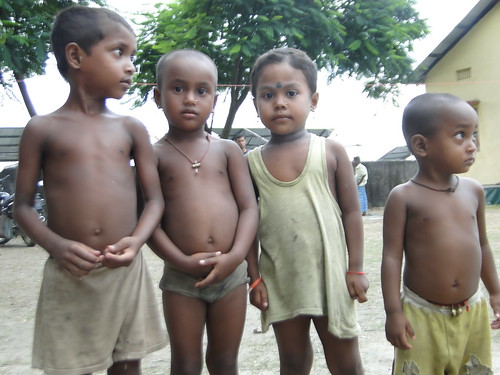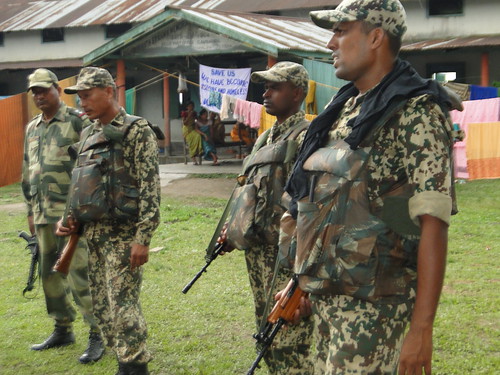By Abdul Kalam Azad for TwoCircles.net,
“Have I Not reason to lament
What man has made of Man?” Wordsworth
Violence always comes with pain, destruction and disparity towards humanity. Being the land of Sankar and Azan, why she suffers these frequently? Perhaps, I can’t answer but like Wordsworth I find many reasons to lament what my fellow citizens are doing for their vested interest. We have seen that the riots in Assam always serve a political motive. It may be Nellie, Udalguri or the recent violence in Bodoland Territorial Autonomous Districts (BTAD). This humanitarian crisis brings opportunity to the politicians grossly!
The recent BTAD riot will also bring prosperities to some politicians. The political analysts are commenting that the riot could be controlled if the concern government would have taken appropriate steps in timely and efficient manner. But they didn’t. On the other hand eminent politician like L.K. Advani didn’t feel necessary to visit the relief camps of minority Muslims in BTAD area rather he summarily termed all of them as illegal Bangladeshi immigrants. At the same tune ASSU advisor Samujjal Bhattarjee advocating not rehabilitating the aggrieved Muslims until and unless their nationality is proved. Those who have lost everything due to the riot; now need to prove their nationality before leaving the relief camp! Isn’t it a cruel political game? Who knows when these politicians demand to stop supplying basic needs to the relief camps! Why they are so reluctant towards humanity? Yes, they are politically motivated and want to cash on the riots, it’s their nature.

BTAD area is a volcano and its ring of fire has spread to the whole nation. The Muslims across the country and beyond; who never bothered about the misery of poor & deprived Muslims of Assam and BTAD got the feeling of brotherhood awakened overnight due to the riots and start threatening migrated Assamese as well as people from other states of North-East India.
Riots in BTAD area have a long history; in 1987 one section of All Bodo Students Union went underground and took up arms[1][1]. Initially, they started attacking Assamese speaking people. Then in 1993 they targeted minority Muslims and killed at least 50 people and made thousands homeless. The attacked continued in 1994 too against Muslims. In 1996, again violence occurred between Bodos and Adivasis. In 2003 BTC accord was signed by Government of India, Government of Assam and Bodo militants. The militants surrendered and formed an interim non-autonomous government under 6th schedule. The BTC accord couldn’t bring peace to the area. In 2008, clash between Bodos and Muslims at Udalguri district claimed more than 100 life. And now in 2012 the clash between Bodos and minority Muslims has been increasing the death toll every day.

The chronological study of the riots in BTAD area shows that, the riots in this area are not only between Bodos and minority Muslims but almost all the non-Bodo communities residing are facing riot or riot like situation. And common Bodo peoples, who even do not know the reason of these riots, are also paying the severe consequences for these riot. Some of demands of the Bodo Movement are against the social fabric of Assam and hazardous to natural justice too. First of all the movement took the path of violence and cause severe bloodshed in Assam as a whole. Their demand of a separate state for Bodos is another threat planning to destroy the social as well as demographic fabric of Assam.
No doubt, the BTC accord was a miscarriage of the plan to resolve the problem permanently. For a short-term political gain central government under the leadership of the than Dy PM L.K. Advani signed the peace pact sacrificing all most all political rights of majority non-Bodos residing within the BTAD area. It is known form various sources that in BTAD area only 29% are Bodos and remaining 71% are non-Bodos. Under this geo-political and demographic circumstances how the government provide autonomous to a minority tribe under 6th schedule. Isn’t it the violation of constitutional right of the majority communities? Secondly, though the militants surrendered before the state; the state didn’t feel it necessary to taken over the illegal arms and ammunitions from the militants! Now, those arms are being used for rioting, extortion and murder. Thirdly, Bodo separatists are still not happy with 6th schedule; they demand a separate state carving 50% of Assam’s geographical area. See, if an extremist group representing about 30% people of 35% geographical area of Assam demands to divide Assam 50/50; what consequences can be expected. Isn’t it indicating that government was not keen to restore peace in the area permanently, but to keep problem alive.

OK, now let’s find out the Bangladeshi in BTAD area as well as in Assam as a whole. Meanwhile the BTAD clash, some politically motivated group as well as some media houses are continuously spearding propaganda that the clash is not between Bodos and Muslims; rather it is fight against the illegal migrants by indigenous Bodo people. Is it really true that illegal Bangladeshi migrants have changed the demography of BTAD area? The census data shows that the population growth rate of Muslims in Kokrajhar during last 40 years is much lower than the national population growth rate of the community during the period. As per the population census 2011, the decadal population growth rate of four districts of BTAD is much lower than the average decadal population growth rate of Assam.[2] [2]
Yes, Population growth is higher among the Muslims of Assam. The reason for this population explosion is not to become majority in terms of voter, but some crucial factors like poverty, lack of family planning, lack of education etc. There is a common notion that Muslims are reluctant towards family planning. But the study of Justice Sachar Committee reveals that “There is a substantial demand from regulation and for modern contraceptives. [3]”[3] Assam’s Health Minister also admitted that the people from minority community are interested in adopting the family planning schemes but the government is not being able to offer the benefit adequately [4][4]. On the other hand education being the most efficient agent to check the population explosion is lagging behind in Muslims community compared to other communities of Assam. As per the population census 2011 Sibsagar district recorded 9.37% decadal population growth against the literacy rate of 81.36%; whereas Barpeta district recorded 21.40% decadal population growth against the literacy of 65.03%. Despite the enactment of RTE Act, there are still 371 Muslim dominated villages in Assam where there is not even a single primary school [5][5]. Jorhat has one primary school against 557 people and at the same time Dhubri has one primary school against 1150 people. Teacher-student ratio in Dhubri district is 89:1 and the same ratio in Jorhat district is 8:1. Inevitably, the result of this injustice is reflected in the population census as well. Dhubri recorded 24.40% decadal population growth rate against 59% literacy rate and Jorhat recorded 9.21% decadal population growth against 83.42% literacy rate [6][6].
The data shows that Assam’s population growth is not abnormal or hampered by illegal migration comparing to national population growth rate. The population census 2011 shows that Assam recorded lower growth than national average. Some chauvinist groups propagate that after 1971 also there was a high influx. But the data does not support the propaganda. Noted historian Dr. Amalendu Guha observed that there was no such immigration during 1971 to 1991, wherever it may be from Bangladesh, Nepal or Bhutan. Either the influx has stopped or same amount of people has been migrated from Assam to outside. During this period India’s population growth was 54% and Assam recorded 53%. On the other hand influx that had happened during 1951 to 1971 was basically non-Muslims. During that period population growth among Muslims was 81.2% which was lower than the 83.4% growth of non-Muslim. Dr. Guha also observed that the migration of Muslims from East Pakistan started from 1901 and continued till mid 40s. After the independence and subsequent partition these migration stopped and migration of Hindu started[7][7].
The hatred against the Muslims took pace after the comment of census commissioner Mulan in 1930. More than 80 years has passed, his speculation proved wrong but the hatred and fear he had planted in the mind of mainstream Assamese people are still being cultivated by the politicians. This fear and hatred were the driving force of Assam Agitation and subsequently Assam Accord and transformation of state power to the agitators. Being in power AGP couldn’t identify the lakhs of illegal Bangladeshis. The reason of this gross failure may be found in the observation of Dr. Guha. And thus they were not interested to update the NRC. It’s almost 27 years, yet the politicians could not manage time to update the NRC and surprisingly AGP was in power for 10 years. Actually updating of NRC will end this political drama and will enable the minority Muslims to get a decent socio-political status, which is not at all desirable for the politicians. We have seen that the pilot project of NRC updation had started with a lot of anomalies to derail the project. When the Muslims demanded to rectify the anomalies and simplify the NRC updation form, police attacked the peaceful picketers, violating the police manual. Political analysts have observed that the police firing at Barpeta was pre-planned by the political party in power[8][8]. One the other hand some chauvinist group termed the picketers as illegal Bangladeshi. Each time, when the minority Muslim faces severe attacks they see the Bangladeshi ghost. The boat capsize at Medhirtary of Dhubri district had mourned the world, but some of the chauvinists welcomed the accident as the victims were Muslims or illegal Bangladeshi migrants as they see it!
These poor-deprived people have been doing their best for the welfare of Assam. They want to assimilate with the mainstream Assamese society by any cost. They have given up their Nobel winner-well acknowledged mother tongue and adopted Assamese during the crisis of Assamese language, established Assamese medium schools across their area. Produced well acclaimed Assamese literary activists like Ismail Hussain, Khabir Ahmed, Hafiz Ahmed etc. But still they are not recognized as the legitimate son of this soil.
This is high time for mainstream Assamese society to decide to open the door for socio-cultural assimilation to strengthen the greater Assamese society or keep them alive for the politicians to be used as scapegoat.
—
Abdul Kalam Azad is based in Guwahati.
[1] http://www.indianexpress.com/news/ethnic-riots-part-of-kokrajhar-history-but-no-lesson-learnt/978919/
[2] http://www.business-standard.com/india/news/mihir-s-sharma-twisting-assam/483544/
[3] Sachar Committee Report
[4] Ali,Dr. Ilus (2011) Jana Bishphuron Aru NHV’r Gurutya, Jagaran, Char Chapori Sahitya Parisad
[5] Ahmed, Hafiz, (2012) Lakhipuror Pora Besimariloi, Bhangun Gatha (NINAD Publishers, Guwahati)
[6] Population Census 2011
[7] Guha, Dr. Amalendu (2011) Brahmaputra Upatyakar Asomiya Somajot Bahiragot: Ek Dristipat Jagaran, Char Chapori Sahitya Parisad.
[8] Sarma, Diganta (2010) Barperta Kanda:Kaar Sristi

